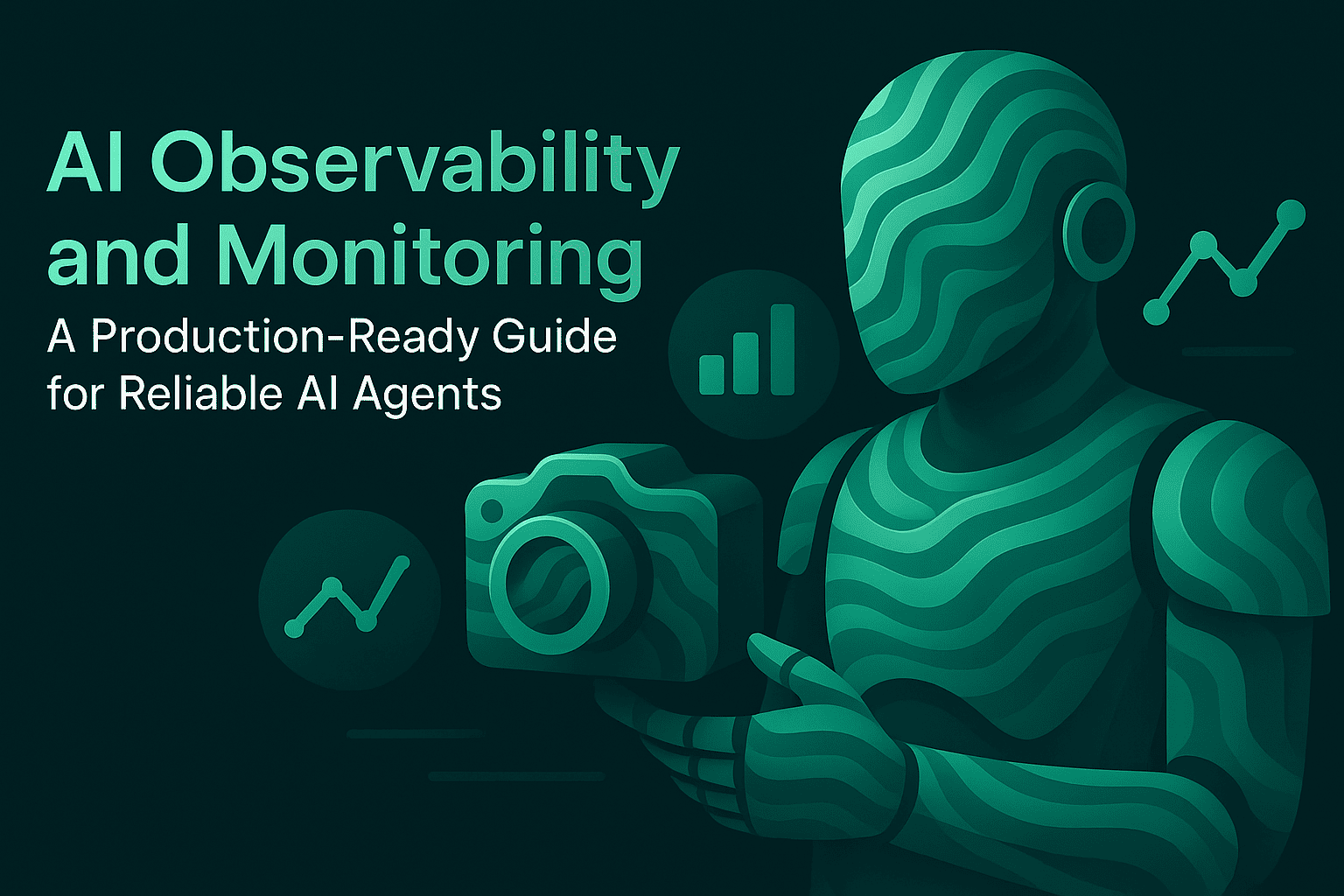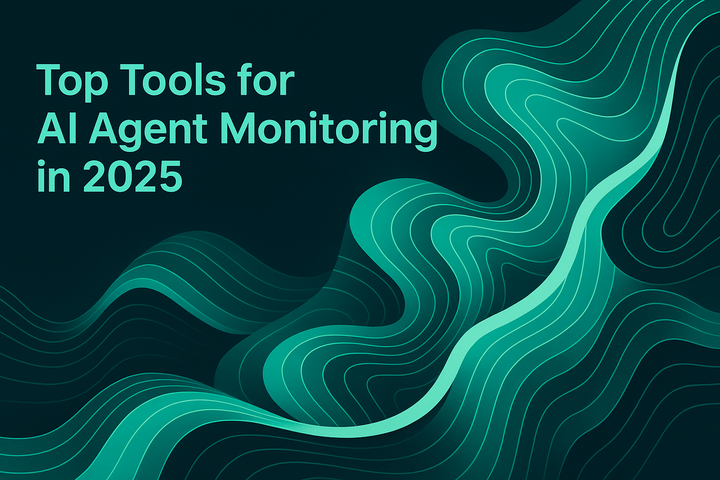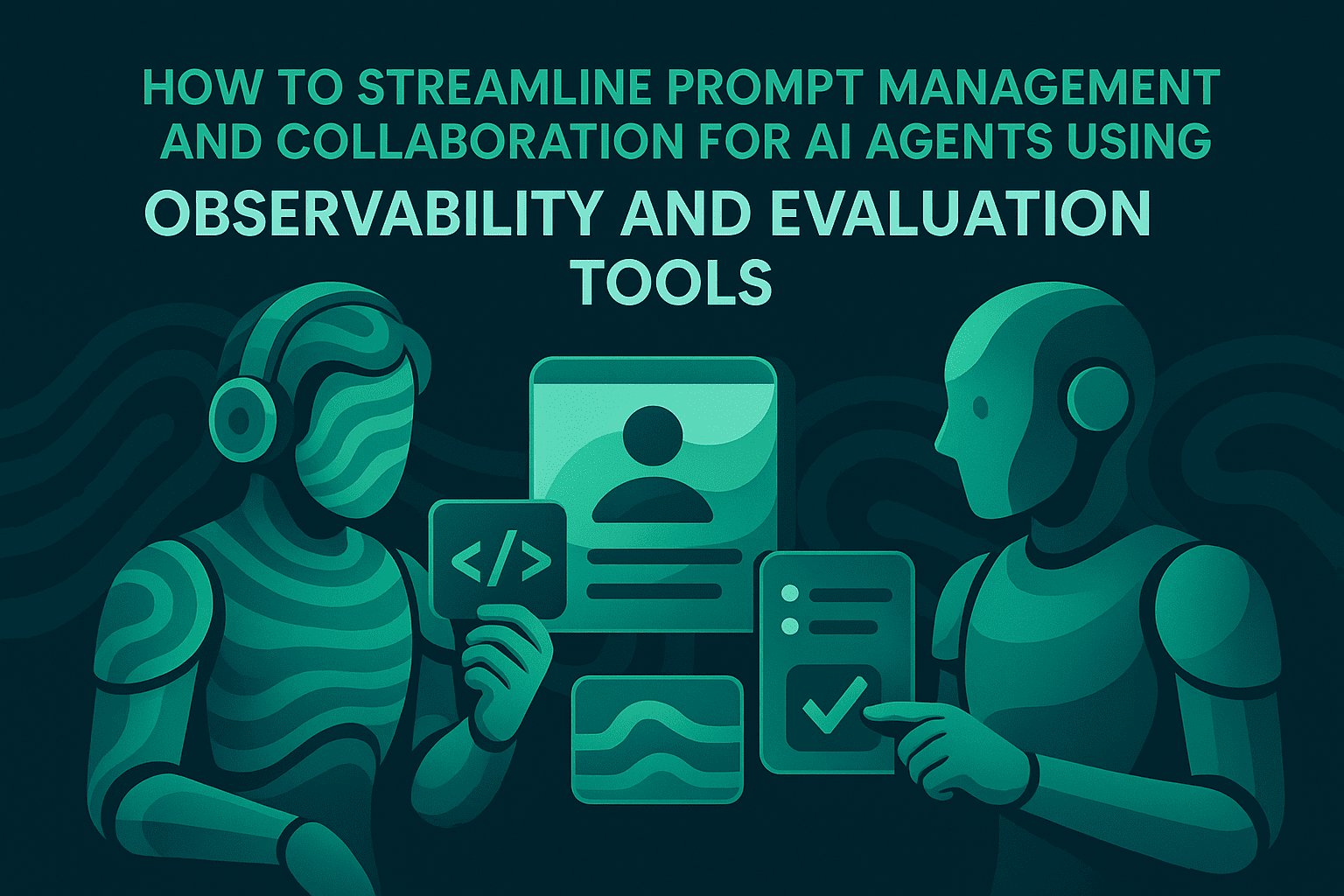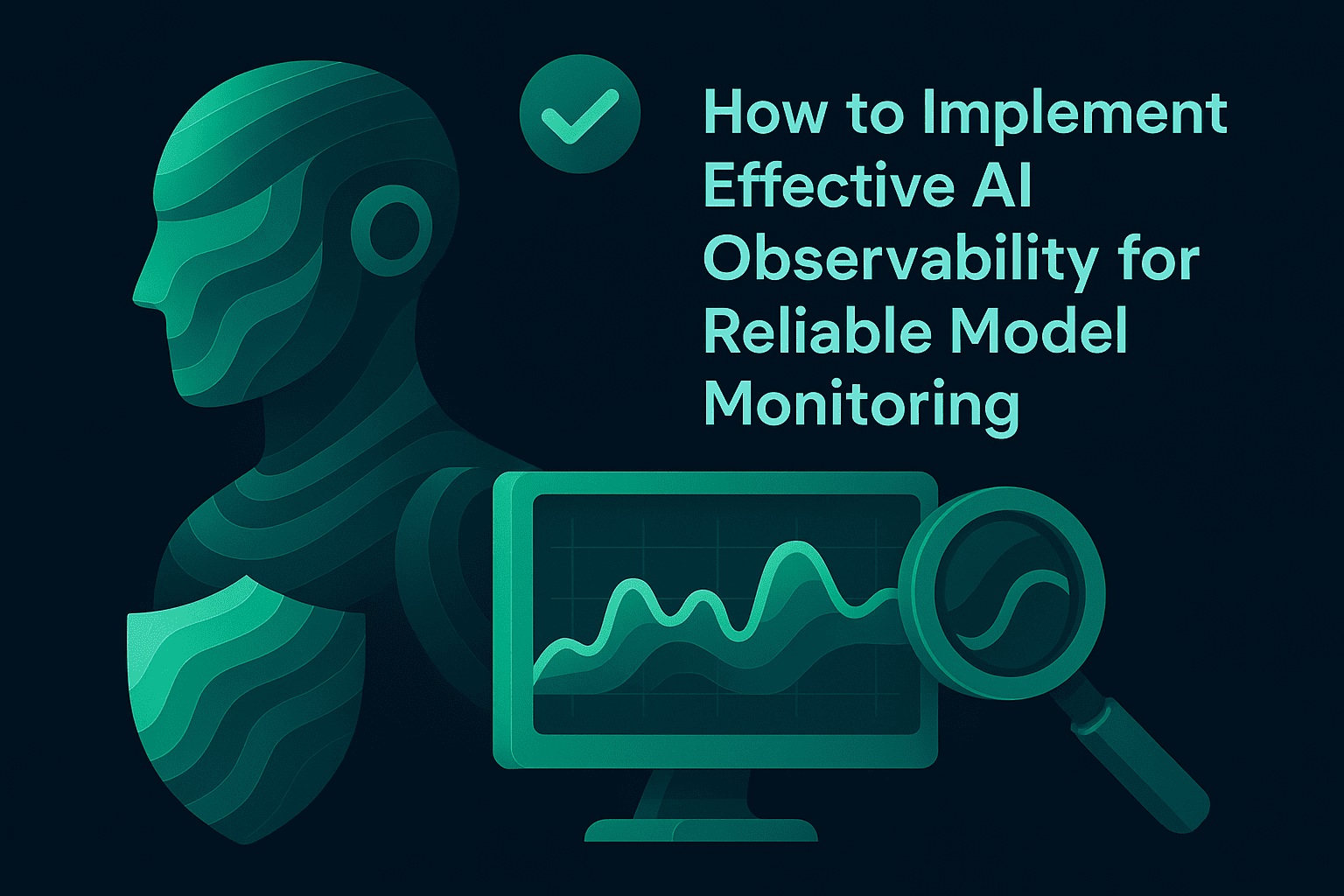AI Observability and Monitoring: A Production-Ready Guide for Reliable AI Agents

Introduction
AI agents have evolved from prototypes to production systems where reliability, safety, and measurable quality determine user trust and business outcomes. Traditional application performance monitoring (APM) covers latency, error rates, and resource saturation, but it does not explain whether an agent satisfied user intent, stayed faithful to retrieved context, or complied with policy constraints.
This guide presents a rigorous, production-ready approach to AI observability and monitoring, including end-to-end traces, online and offline evaluations, human review workflows, targeted alerts, and data curation pipelines. It draws on open standards like OpenTelemetry and proven practices implemented through Maxim AI's products for simulation, evaluation, and observability.
What Is AI Observability?
AI observability is the continuous practice of tracing agent workflows end to end, evaluating quality online and offline, routing ambiguous cases to human review, and alerting on user-impacting issues with governance that curates production data into test suites and training sets.
Observability differs from simple logging by capturing the content, context, and computation of AI decisions across sessions, steps, tool calls, and retrieval operations. In production environments, this enables teams to reproduce issues precisely, localize failures by node, and use evaluator signals to drive remediation and iteration. Maxim structures traces, online evaluators, and human review workflows with SDKs, dashboards, and alerting capabilities that integrate seamlessly into existing pipelines.
Observability vs. Monitoring
Monitoring tracks system health signals like latency and error rates. Observability explains agent behavior and quality outcomes.
Observability tells you whether the response was correct, grounded, safe, and aligned with user intent. Production-grade reliability requires both.
Observability layers semantic signals on top of system metrics by storing prompts, tool inputs and outputs, retrieved context, evaluator scores, and human annotations in session and span structures that teams can analyze consistently. Teams can implement instrumentation, evaluator configuration, and dashboard patterns tailored to multi-agent pipelines using open standards.
Why Observability Matters for AI Agents
Non-determinism, multi-step workflows, and context-dependent behavior make quality regressions hard to detect with system metrics alone. Agents can produce different outputs for identical inputs based on temperature settings, retrieval variance, or tool outcomes.
In production, observability reduces mean time to detect and diagnose by correlating session-level outcomes with node-level signals like retrieval quality, tool-call correctness, and guardrail triggers. Maxim's continuous online evaluations run on live traffic and escalate low-scoring sessions to human review, improving quality with each release cycle.
Key Components
Traces
End-to-end visibility across agent steps, models, prompts, tools, and retrieval enables teams to understand complex workflows. Granular spans capture inputs, outputs, parameters, and latencies, while visual trace views help teams pinpoint branching behavior and retries across distributed systems.
Online Evaluations
Automated scoring runs on live traffic to assess task success, faithfulness to context, toxicity, PII leakage, format adherence, and tool correctness. Evaluator thresholds configured in production drive alerts and route sessions to human review queues when quality signals degrade.
Offline Evaluations
Pre-deployment tests run across stable suites for prompts, models, and workflows, supporting A/B decisions, CI hooks, and version comparisons. Maxim's simulation and evaluation platform enables teams to validate changes before they reach production traffic.
Human-in-the-Loop
Targeted annotation addresses high-stakes or ambiguous cases that automated evaluators cannot reliably judge. Multi-dimensional rubrics with inter-rater checks ensure reliable ground truth and evaluator calibration across review cycles.
Alerts
Low-noise, real-time signals trigger on evaluator thresholds, tool failure spikes, retrieval outages, cost budgets, and latency tails. Integrations with Slack, PagerDuty, and webhooks route incidents to on-call channels with deep links to traces for faster triage.
Data Engine
Production logs become curated datasets with privacy controls, lineage tracking, and clustering by failure mode. Maxim's data curation workflows promote labeled examples into evaluator stores and regression tests that prevent quality drift.
Core Metrics and What to Track
Session-Level Metrics
- Task success rate and abandonment
- End-to-end latency by percentile and persona
- Cost per resolved task and per failure mode
Node-Level Metrics
- Retrieval recall, precision, and overlap
- Tool call correctness, retries, and timeouts
- Schema adherence and parsing validity for structured outputs
- Guardrail triggers, including toxicity, bias, and PII flags
Quality Dimensions for Evaluators
- Faithfulness to the retrieved context in RAG flows
- Answer relevance and completeness for intent satisfaction
- Safety and policy compliance
- Format correctness for API consumption and downstream automation
Maxim's unified evaluation framework supports deterministic rules, statistical metrics, and LLM-as-a-judge evaluators with safeguards for scaling reliable judgments across production workloads, complemented by human review for nuanced domains.
Actionable Best Practices for Reliable AI Observability
Instrument consistently with open standards
Use OpenTelemetry across services and agent orchestration to emit LLM and tool spans with shared semantic conventions. Store prompt versions, model parameters, retrieval metadata, and costs as span attributes for reproducibility in Maxim's instrumentation framework.
Start with a minimal evaluator bundle
For RAG assistants, prioritize Task Success, Faithfulness, Toxicity, PII leakage, and Format adherence. Add domain-specific evaluators over time. Tie thresholds to SLOs for rolling windows and route violations to human review workflows with clear adjudication criteria.
Sample online evaluations strategically
Begin with 5 to 10 percent of sessions per surface, higher for new versions and high-risk routes. Escalate low-scoring sessions with rubrics and SLAs to ensure timely adjudication through Maxim's review queues.
Define alerts around user outcomes
Monitor evaluator thresholds, retrieval outages, tool error spikes, tail latency, and cost budgets per workflow. Include trace links and recent evaluation trends for faster triage using integrated alerting systems.
Close the loop with data curation
Promote reviewed examples into curated datasets. Cluster by failure modes and personas. Schedule nightly offline regressions on builds and publish weekly reliability digests with version deltas through Maxim's data engine.
Key Challenges and How to Overcome Them
Non-determinism
Responses vary across runs. Mitigate with detailed span attributes, versioned prompts, and controlled parameters. Use simulation environments to explore variance and build robust evaluator coverage before production deployment.
Long-running workflows
Multi-agent pipelines introduce branching and retries. Resolve with hierarchical traces and visual views that localize failures to specific nodes or tools across distributed systems.
Evaluation ambiguity
Automated metrics can misalign with human judgments for nuanced tasks. Combine LLM-as-a-judge evaluators with targeted human review and adjust thresholds using adjudication feedback to improve reliability over time.
Data governance
Privacy and compliance require masking, role-based access, and auditable lineage from log to dataset to deployment. Use in-VPC deployment options and policy-aligned retention to meet enterprise security requirements.
Compare Tools for AI Observability
The table below summarizes common capabilities based on the requirements of production-grade agent observability. It emphasizes end-to-end tracing, evaluation depth, human-in-the-loop support, alerting, governance, and open standards compatibility.
| Tool | Agent Tracing | Evaluations (Online/Offline) | Human Review | Alerts & Integrations | Open Standards | Enterprise Features |
|---|---|---|---|---|---|---|
| Maxim AI | Comprehensive multi-span across LLM + tools | Unified evaluators; offline suites | Queues, rubrics, adjudication | Slack, PagerDuty, webhooks | OpenTelemetry; CSV/API export | SOC 2, HIPAA/GDPR, in-VPC, RBAC |
| Langfuse | LLM tracing and analytics | Baseline eval + feedback | Limited built-in | Basic alerts | Open source; self-host | Developer-centric |
| Arize Phoenix | Tracing + drift analytics | Strong model monitoring | Varies by setup | Enterprise dashboards | Broad MLOps integrations | Enterprise oriented |
| Helicone | Proxy logging for prompts/responses | Lightweight analysis | Not primary focus | Simple notifications | Quick API visibility | Open source options |
| Lunary | Prompt management + monitoring | Eval + version tracking | Not primary focus | Standard alerts | Self-host flexibility | Team workflows |
Short Analysis
Teams that need end-to-end agent observability with evaluation depth, human review, governance, and open standards compatibility benefit most from Maxim's integrated platform. Developer-centric, open-source tools such as Langfuse and Helicone accelerate early-stage tracing and prompt iteration but generally require stitching together additional systems for evaluations, human workflows, and enterprise controls.
Platforms oriented to traditional model monitoring, like Arize Phoenix, are strong for drift and performance analytics and may complement agent observability for hybrid stacks. For a comprehensive, production-ready workflow spanning experimentation, simulation, evaluation, and observability in one place, teams can leverage Maxim AI's unified approach.
Visualizing the Observability Stack in an AI Agent Pipeline
Consider a customer support agent that retrieves knowledge base articles, calls internal tools, and generates structured responses.
Instrumentation and Tracing
The orchestration layer emits OpenTelemetry spans for each step: user turn, retrieval query, LLM call, tool invocation, and schema validation. Attributes include prompt version, model parameters, retrieval provenance, tool arguments, costs, and errors captured through Maxim's instrumentation framework.
Online Evaluations
Live sessions are sampled at 10 percent. Evaluators score Task Success, Faithfulness to retrieved context, Toxicity, PII leakage, and Format adherence. Low faithfulness or safety flags trigger alerts and push sessions to human review queues for expert adjudication.
Human Review
SMEs adjudicate flagged outputs with rubrics. Labels retrain or recalibrate evaluators and feed Maxim's data engine for curated datasets that improve future model performance.
Dashboards and Alerts
Dashboards show session outcomes, node failures, cost per resolution, and tail latency. Alerts include deep links to traces for rapid triage.
Offline Regression Loop
Reviewed sessions become test suites. Nightly runs measure version deltas and publish reliability digests. Teams resolve regressions before broad rollouts using simulation and evaluation workflows.
Measurable Impact
- Reduced mean time to detect issues by correlating evaluator thresholds with trace context
- Lower hallucination rates by improving retrieval and prompt design based on faithfulness scores
- Controlled costs through token tracking, tool latency analysis, and cost-per-resolution budgets
Key Takeaways
- Observability augments monitoring with semantic signals that explain agent quality and user outcomes
- End-to-end traces, online evaluations, human review, targeted alerts, and data curation form a cohesive reliability loop
- Start with a minimal evaluator bundle, instrument with open standards, and route ambiguous sessions to human review
- Use simulations and offline regressions to prevent quality regressions before deployment, then continue online evaluations post-release
- Adopt governance with auditable lineage and privacy-safe logging to operationalize compliance
Conclusion
Production AI agents need disciplined observability and monitoring that go beyond infrastructure metrics. Maxim AI provides an integrated platform for experimentation, simulation, evaluation, and observability so engineering and product teams can measure, improve, and ship reliable AI experiences faster.
Explore Maxim's Agent Observability, unified evaluation framework, and simulation capabilities to build a continuous quality loop anchored in evidence.
Request a live walkthrough to see these workflows in action or sign up to get started today.


